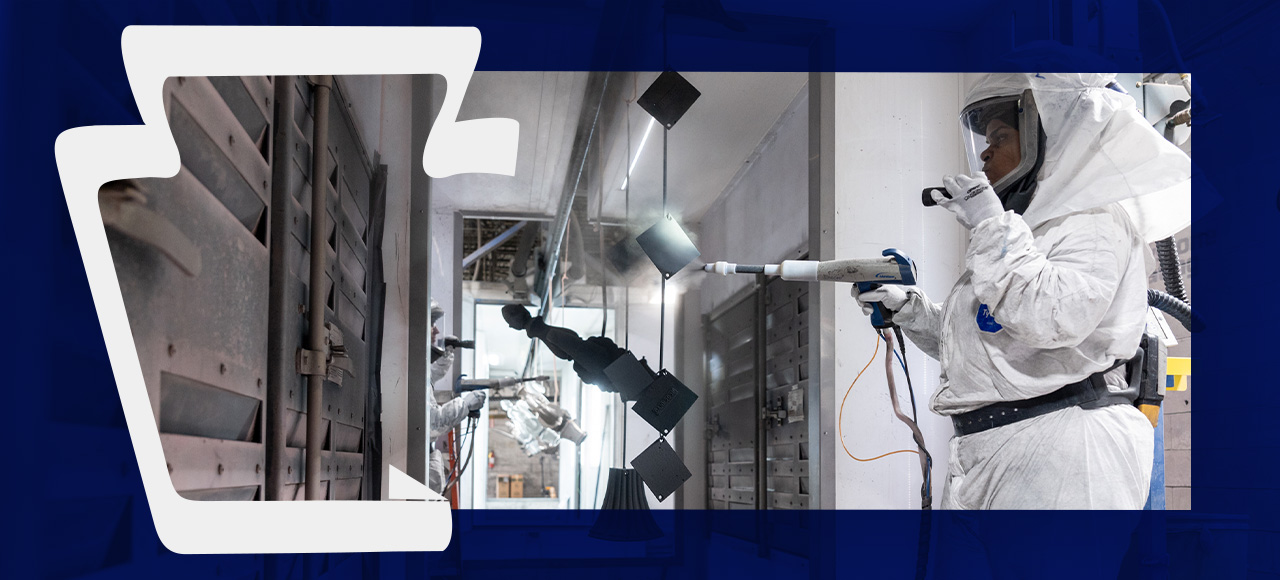
Updated October 14, 2024. Originally published April 4, 2023.
Powder coating typically provides robust protection against wear and tear. This surface coating method is durable and adheres better than paint, protecting the part better and longer. Despite its durability, a powder coating can still flake and peel over time. A peeling powder coat leaves the metal with an unappealing look and exposes it to the environment, which can corrode the structure and shorten its life span. Here are a few reasons your powder coating might peel, ways to fix it and tips for preventing it.
Why Powder Coating Is Peeling Off
Powder coating may peel off for several reasons. If it begins to peel very soon after it is coated, it is likely due to a flaw in the preparation method prior to coating. It can also peel due to damage or aging. Here are the most common powder coating peel off reasons:
- Surface preparation: Oils and contaminants on a metal’s surface can prevent proper adhesion. An in-depth surface preparation procedure, such as etching, sandblasting or sanding and thoroughly cleaning the surface afterward, can increase durability.
- Substrate material: Metallic substrates like steel and aluminum work well for coating, while soft materials like plastics do not.
- Equipment or technique: The equipment and application techniques used can impact how long a layer will last. Professional equipment and services keep a coating better for longer.
- Regular wear and tear: An area exposed to frequent impact or abrasion will peel faster. For example, powder-coated parts of heavy machinery will likely peel in areas where they rub against one another.
- Ultraviolet (UV) light: Equipment used outside is often exposed to high levels of UV light. This light can break down the coating, making it weaker and more likely to flake off.
How to Repair Peeling Powder Coating
When a powder coat begins to peel, your best option is to get it redone. This process involves blasting off any flaking coating and then sanding the edges to provide a smoother surface where the old and new coatings will overlap. Once prepared and thoroughly cleaned, the piece can go through a normal powder coating process.
Note that applying a new coating to only certain areas will likely provide an uneven finish. While it will still protect the material, it may not look as smooth as you would like, especially on a glossy surface. The piece must be blasted until the bare metal is exposed everywhere to achieve a smooth finish. Then, a new coat can be applied.
How to Prevent Powder Coating From Peeling
While flaking powder coating can be fixed, learning how to keep powder coat from peeling in the first place will save you time and money. Here are some tips to protect your powder coating:
Keep Your Powder Coating Clean
Clean your powder-coated items regularly, at least every three months. If they are in a high-traffic area or exposed to extreme environmental conditions, you may want to clean them more frequently. Removing dirt or other debris will prevent buildup that can harm your finish. Strong chemical cleaners like solvents or petroleum-based products can damage powder-coated surfaces, so use mild soap and water instead, and avoid power-washing your items. Opt for soft cloths or sponges that won’t cause scratches.
Protect Your Equipment From the Environment
Powder coating is durable, but long-term exposure to the elements can cause a powder coating peel off problem. If a piece of equipment is outside, the surface may be damaged by intense periods of hot and cold, too much direct sunlight or rain. In coastal areas, the presence of salt water also contributes to peeling. Be sure to take the appropriate measures to safeguard your equipment from harsh weather.
Inspect for Damage
When you evaluate your equipment, here are some early warning signs that your powder coating is beginning to break down:
- Small flakes or chips: Powder-coated surfaces shouldn’t chip or flake easily. If you notice small pieces of the coating are beginning to come off, it indicates that the coating isn’t adhering properly.
- Chalking: When UV light or weather conditions begin to affect the powder coating, it may develop a faded layer on the surface.
- Rough spots: When dirt or contaminants begin to build up, your powder coating will feel rough or uneven to the touch.
- Cracking: Cracking indicates that the coating is expanding and contracting beyond its limits. When this happens, water and oxygen can intrude down to the substrate and spread until the coating starts flaking off in larger pieces. This issue can also damage the substrate.
You may be able to extend the life of your coating by moving equipment to a new location or changing your cleaning schedule. If the coating is already beginning to peel or the chalking doesn’t improve with cleaning, consider a professional repair.
Why Trust Us for Your Powder Coating?
If you’re concerned about the longevity of your powder coating, Keystone Koating offers an eight-stage pretreatment system for parts that promotes adhesion, providing greater long-term protection. Our powder coating process offers corrosion protection, and we can turn around a large number of parts in a short amount of time.
Powder Coating From Keystone Koating
We can recoat your peeling equipment to provide better protection and a cleaner look. We can apply a new powder coating across the entire piece, and we can get it done quickly and professionally. Contact us for a quote.

